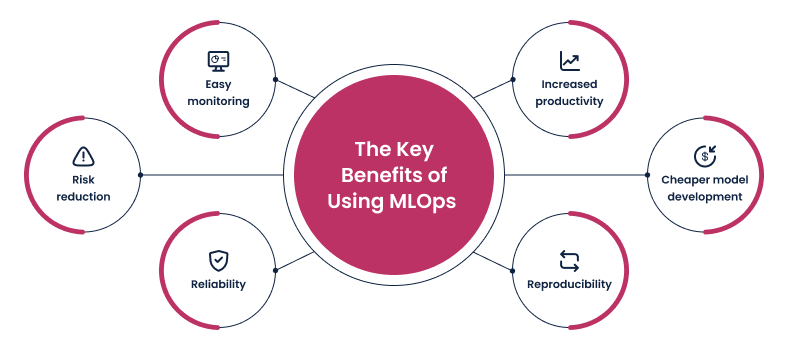If you want your business to become data-driven, then most likely you will start with AI and ML development services. Thankfully, there is a way to build your own ML model without unnecessary hurdles and overwhelming costs.
Today, we want to discuss machine learning operations and how they can be beneficial for you.
What Is MLOps?
Machine learning operations (MLOps) are a set of methods to make ML model development as efficient as possible. They combine best practices from development operations (DevOps) with machine learning engineering. The result? Streamlined development, robust model monitoring, and, more importantly, cost efficiency.

MLOps can be split into phases.
- Problem Definition: Before development starts, you need to define the problem you want to tackle with your machine learning model and how it will approach this problem.
- Data Collection and Preparation: The more data you gather, the better it is for model training. Do remember that you need to label and structure it properly.
- Model Development: At this point, you start creating and training your machine learning model. Let your development team’s imagination fly – encourage experimentation to find the best-performing algorithm that will fit you.
- Model Evaluation: Remember when we defined the problem? Now, it’s time to evaluate your model’s performance using the metrics you defined at that phase.
- Model Deployment: Set up your infrastructure and get ready for the model to hit production! However, your work is not done yet.
- Monitoring and Maintenance: Now that your model is live, you need to maintain it. A good practice is to monitor it as well. This way, you can gather valuable insights that will be useful in the future.
- Feedback: This phase is pretty much self-explanatory. Gather feedback about the model performance. Use the collected data for developing updates, model training, and addressing issues that might have occurred. Conducting exploratory data analysis is crucial.
- Scaling: It’s time for your model to start handling larger datasets. This process will involve a lot of pipeline optimization for future cost-efficiency, among other things. Machine learning workloads are defining points in evaluating performance.
- Governance: Ensure your machine learning model complies with regulatory standards. Pay attention to its privacy and security.
- Collaboration: Encourage collaboration between data scientists, developers, and maintenance teams. Knowledge sharing will improve the model’s general health and spread the use of best practices.
That’s all the phases. The important thing about them is that they are iterative, meaning your MLOps team will cycle through them several times. This ensures continuous integration, allowing you to improve it as much as you want.
That’s cool and all, but who in the world benefits from using the MLOps approach? Let’s talk about that.
Who Benefits From Using MLOps?

Generally, MLOps benefits organizations of different sizes by improving the efficiency and reliability of their ML workflows. But that’s a somewhat vague explanation, so let’s cover everyone interested in the use of MLOps benefits.
Data Scientists
Instead of constantly maintaining machine learning models, data scientists can actually do what they were hired for – experiment and find new ways of creating models. MLOps streamlines their workflow, which frees up time to improve models.
Developers
Imagine you planned a standup at work, and half of the team showed up expecting to hear jokes. This shows a clear lack of standardization among your colleagues, which can be solved with MLOps implementation. Standardization is great not only for saving yourself from ruined expectations but also for reducing the time and effort required for integrating machine learning models into applications.
Operations Teams
Operation teams are responsible for managing and monitoring machine learning models’ production. They also ensure the model performance is optimal. To do their job right, they need to have proper tools and apply the best practices. It so happens that MLOps provides operations teams with just that.
Business Stakeholders
Any business stakeholder will say that best practices are cost-efficient. It just so happens that MLOps is considered to be the best practice for machine learning model development. So, the idea of adopting MLOps practices for ML, which they see as an “infinite value machine” will encounter little to no pushback. And why would they be against it? MLOps allows for faster deployment of machine learning models, which leads to profound insights and fruitful sales.
Customers
Overall any change that improves customer experience will be met warmly. But the best changes are the ones that feel like they have always been there. The customer won’t necessarily notice personalized recommendations or predictive technologies in their app, but that’s only because such changes feel like something natural. MLOps offers a framework for the development of predictive analysis.
As you can see, MLOps principles are beneficial for all parties, from stakeholders to the data engineering department and customers. Now, let’s cover those benefits in more detail.
6 Key Benefits Of Using MLOps
The main MLOps advantages are increased productivity, cheaper model development, reproducibility, reliability, risk reduction, and ease of monitoring. How exciting is that? Read more about each of these benefits below.

Benefit 1: Increased productivity
There are two ways MLOps improves productivity:
- Automation. When developing a machine learning model, you will encounter a lot of repetitive tasks. MLOps helps automate your workflow and prevents potential human input errors.
- Standardization. While using MLOps, you’ll quickly notice another pleasant surprise in the form of standardization. It allows for better compatibility between different models and will come in handy during version control.
Benefit 2: Cheaper model development
MLOps significantly cut the costs of machine learning projects development through all work stages:
- Automation lowers manual efforts, which enables your employees to do more complex and creative tasks.
- Decreased number of errors also reduces costs since there’s less stuff to fix.
Benefit 3: Reproducibility
As we already mentioned, MLOps is iterative. This leads to the following.
- Data versioning. Every dataset created has multiple snapshots (versions) from a specific point in time with specific data inside. With data versioning, you can get back to the past at any given moment.
- Model versioning. By the same principle, every model created has multiple versions. Each of the model versions captures the model in different development stages, capturing features built at these stages.

Benefit 4: Reliability
Reliability is guaranteed by:
- Streamlined processes. One of the biggest challenges during ML development is scaling from a small model to a larger system. By incorporating DevOps principles, MLOps streamlines model management, which results in reliable scaling.
- Automation. ML pipeline automation reduces the chances of human error, making models more reliable. Thanks to automation, MLOps allows for quick scaling of model management procedures.
Benefit 5: Easy monitoring
Monitoring machine learning models’ behavior and performance is essential because they can change because of shifts in the real-world environment. But that’s not all monitoring is useful for.
- Model retraining. By constantly retraining ML models, you can provide consistency in its outputs. To make this process easier, MLOps provides automation for retraining and monitoring the model after specific events in the system.
- Alerts. MLOps can also share the real-time status of your model and data by alerting data scientists’ teams in case of model drift. This allows for a quick response against model degradation.
Exploring MLOps Use Cases: 8 Real-World Examples and Applications
Continue reading
Benefit 6: Risk reduction
When it comes to risks, there are two general risks you might encounter:
- Machine learning models often need regulation and drift checks. It is easy to oversee some of the industry regulations or when the model starts to drift. Fixing it could be very time-consuming, but not with MLOps. It enables greater transparency and ensures compliance with industry regulations.
- MLOps focuses on reducing the risk of deploying faulty or biased models in production environments. You can achieve it by implementing robust testing and quality assurance processes.
Final Thoughts
If you are looking into machine learning development, you should consider the use of MLOps. You might think about MLOps solutions as a new fancy trend that will be forgotten in a couple of months, but this is far from true.
As we covered, there are clear benefits to adopting the MLops platform. High accuracy, reliability, cost reduction, and little to no human errors are the main strong sides. In other words, it helps you deploy your AI solution faster with fewer bugs. Why would you say no to this?
This article is an introduction to MLOps. But to actually use it, you need experts from CHI Software. If you want your company to become data-driven but yet to have proper internal resources, contact us today. We’re ready to introduce you to the full spectrum of our expertise in MLOps consulting.
About the author
Alex is a Data Scientist & ML Engineer with an NLP specialization. He is passionate about AI-related technologies, fond of science, and participated in many international scientific conferences.
Rate this article
25 ratings, average: 4.52 out of 5






